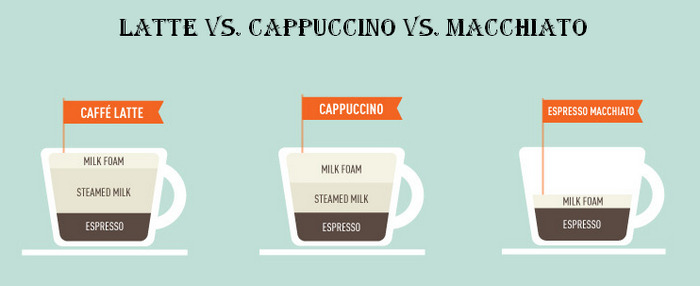

On the other hand, a ‘wet’ cappuccino will contain less foam on top. While in Italy, this is a breakfast drink and it is not considered socially acceptable to drink milky coffee after lunchtime. Because it contains less steamed milk, you can expect a stronger espresso taste coming through from the espresso shot.Ĭappuccinos can also be made more ‘dry’ by stretching the milk further to give it a lighter, fluffier texture with even more foam. Similar to a latte, a cappuccino starts with one or two shots of espresso, which is then followed by steamed milk and a distinct thick layer of foam, the ratio, and balance of which is very important. Today, some countries still add chocolate powder to cappuccinos, such as Australia, while others moved away from this tradition and serve these drinks without the chocolate dusting. Whether you get a touch of chocolate or not, depends on the cafe as well as the current trend, which, at the moment, is to ditch the chocolate. Even though the word was first used in Vienna, Italy is believed to have invented the modern-day version of cappuccino. When the drink was first being made in Vienna, it was combined with whipped cream as well as chocolate or cinnamon, which is where the tradition of chocolate on cappuccinos comes from. It is believed that these additional flavors were added to milky coffees in Vienna in order to mask the poor quality of an espresso. This is because the first coffees that were made in Vienna in the 18th century resembled the robes worn by these monks ( *). The name “cappuccino” comes from the order of Capuchin monks in the Roman Catholic Church, the word ‘capuchin’ meaning ‘small hood’ in Italian. The creamy texture of a latte is so delightful that it has been adapted to create drinks that don’t even contain coffee, such as the matcha latte, chai latte, or turmeric latte. Outside of Italy, a latte means a single or double espresso shot, depending on the country, combined with steamed milk to create a rich and creamy drink with a thin layer of foam on top. The espresso taste of a latte is very subtle and the drink has a satisfying creamy texture that can be combined with additional flavors such as vanilla or hazelnut. Since ‘latte’ means milk in Italian, if you forget to mention the “cafe” component when ordering, you will just receive a glass of milk and a condescending look. Then it was adopted by America and popularised by Starbucks, spreading across the world. The latte was created in Europe, either in Italy as “cafe latte” or France as “cafe au lait” - they still can’t decide. Since you cannot make a good latte or a cappuccino without starting with great espresso, the first step is to perfect this component first. Making a great espresso shot is a result of the perfect balance between grind, temperature and pressure. This drink is usually brewed within 30 seconds and only results in a 30ml or 1-ounce concentrated caffeine blast. They offer different textures and experiences because of the amount of foam used.īefore we go into the differences between a latte and a cappuccino, let’s establish what they have in common, and that is the same essential ingredient, an espresso.Īn espresso is a small shot of coffee that was invented in Italy and is made through a method in which highly pressurized hot water is forced through very fine coffee grounds. These two espresso-based drinks enjoy popularity because they both tone down the bitterness and strong coffee taste.

The key difference is the ratio between these components and the amount of foam each of them contains. While cappuccinos and lattes are two different beverages, they have a lot of things in common, which is why the distinction between the two can sometimes be blurred.īoth coffee drinks contain espresso shots, steamed milk, and milk froth on the top. This article will dive into the similarities and key disparities between these two popular coffee drinks so the next time you’re at the cafe, you can order like a pro. However, not all cafes or coffee drinkers know what’s the difference between a latte and a cappuccino. They both contain the same ingredients: espresso coffee, steamed milk, and milk foam on top-but result in a different taste and experience. The latte and cappuccino remain among the most popular coffee orders.

When you come to a cafe, you can order a flat white, macchiato, mocha, or cortado, all of which include varying ratios of coffee and milk. Today, there are so many coffee drinks that experiment with different combinations of the perfect flavor duo: coffee and milk. One of the most common questions baristas get asked is: “ what is the difference between a latte and a cappuccino?”


 0 kommentar(er)
0 kommentar(er)
